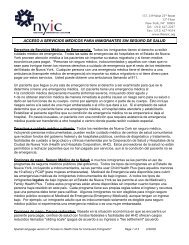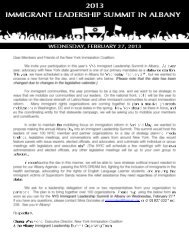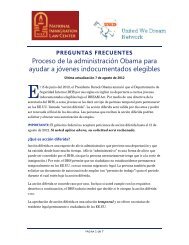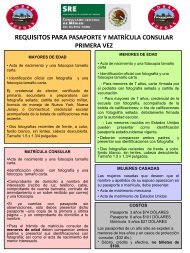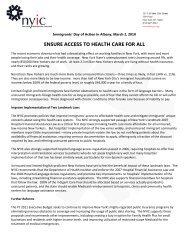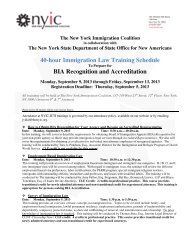Major Legislative Milestones in US Immigration History - New York ...
Major Legislative Milestones in US Immigration History - New York ...
Major Legislative Milestones in US Immigration History - New York ...
You also want an ePaper? Increase the reach of your titles
YUMPU automatically turns print PDFs into web optimized ePapers that Google loves.
ical home” would ensure that un<strong>in</strong>sured participants would not be deterredfrom seek<strong>in</strong>g needed medical care due to fear of devastat<strong>in</strong>g medical debt orimmigration-related concerns. Currently, too few immigrants <strong>in</strong> <strong>New</strong> <strong>York</strong> Cityunderstand the options for affordable care available through the health caresafety net, and they delay care until their conditions become serious, result<strong>in</strong>g<strong>in</strong> poorer health and more costly care down the l<strong>in</strong>e. 22The health care safety net is already burdened by the uncompensated andunder-compensated care it provides — a burden that is partially expla<strong>in</strong>ed bythe system’s failure to proactively undertake patient education and outreachabout the availability of reduced-cost care, outpatient services, and public coverage.23 Un<strong>in</strong>sured <strong>US</strong> residents, and immigrants <strong>in</strong> particular, often receivethe full bill for services, when <strong>in</strong> actuality there are reductions that could beapplied, or coverage for which people are eligible but not enrolled. This confusionresults <strong>in</strong> large numbers of un<strong>in</strong>sured residents who are unable or afraid toseek health care.Advantages of the Safety Net “Medical Home” Establish<strong>in</strong>g a “medical home” would greatly <strong>in</strong>crease the likelihood thathealth care would be obta<strong>in</strong>ed <strong>in</strong> a timely and cost-effective way throughpreventive and primary care. Health providers could adapt their exist<strong>in</strong>g bill<strong>in</strong>g and claims systems. Participants could obta<strong>in</strong> care through outpatient and cl<strong>in</strong>ical sett<strong>in</strong>gs,rather than rely<strong>in</strong>g on much more costly emergency care. This option would make it more likely that participants could receive culturallycompetent, l<strong>in</strong>guistically accessible services regardless of their abilityto pay, and further, that low-cost payment options would be available, suchas slid<strong>in</strong>g-scale fee reductions. It would provide access to comprehensive care <strong>in</strong> most regions <strong>in</strong> theUnited States.22 M. Doty, J. Edwards, and A. Holmgren, “See<strong>in</strong>g Red: Americans Driven <strong>in</strong>to Debt by Medical Bills” (<strong>New</strong><strong>York</strong>: The Commonwealth Fund, 2005).23 E. Benjam<strong>in</strong> et al., “State Secret: How Government Fails to Ensure that Un<strong>in</strong>sured and Under<strong>in</strong>suredPatients Have Access to State Charity Care Funds” (<strong>New</strong> <strong>York</strong>: The Legal Aid Society — Health Law Unit,2004). See also, “Hospital Free Care: Can <strong>New</strong> <strong>York</strong>ers Access Hospital Services Paid for by Our TaxDollars?” (<strong>New</strong> <strong>York</strong>: Public Policy and Education Fund of <strong>New</strong> <strong>York</strong>, 2003).A ppendix II 175





